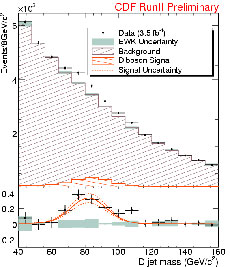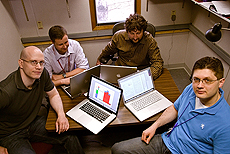CDF diboson observation a big step toward Higgs

(Top) A comparison of the reconstructed mass of the two jets in the data events and the background model. A clear excess can be seen around the mass of the W/Z. (Bottom) The difference between the data and the background model reveals our signal peak. Calorimeter resolution prevents W and Z masses from being distinguishable.
In order to convince someone that you could land on the moon, you would first need to convince that person that you could launch someone into space. Similarly, before anyone will believe it is possible to see the Higgs boson, we must show that it is possible to observe the diboson process.
Recently, scientists at the CDF collaboration reached this first milestone when they searched for and observed the decay of a pair of W or Z bosons in which one of the pair decays into two particle jets and other into two leptons.
Physicists already know that the Tevatron can produce collision events with W/Z pairs. These events were observed in data samples that had very few contaminating background events. The samples had few background events because scientists required that both bosons decay into leptons. However, when one of the bosons in the sought-for process decays to a jet pair rather than a lepton pair,an overwhelming number of background events obscure the diboson contribution. These events come from processes in which the observed jets originate from more common QCD-production mechanisms. In fact, there are thousands of background events for every signal event.
Still, requiring one of the bosons to decay to a jet pair is of particular interest for the following reason: the event signature looks very much like that of a light Higgs particle, in which the Higgs decays to two jets alongside the leptonic decay of a W or Z. Due to the higher production rate of the diboson process, scientists must be able to observe this process before they can hope to isolate the even smaller potential contribution in this final state originating from Higgs boson production.
In order to make identifying the signal easier, CDF scientists reduced the number of background events by requiring a large energy imbalance in the calorimeter. This imbalance was due to non-interacting neutrinos of the W or Z decay. Additionally, an event-by-event figure of merit, which further discriminated against fake imbalances due to energy mismeasurement, was applied to the sample. With backgrounds under control, a distribution of the masses of the jet pairs from each event indicated a bump in the region of the W and Z masses (80.4 and 90.1 GeV/c2, respectively), as seen in the figure. The next step is to seek diboson pairs with even more Higgs-like decay signatures by requiring b-quark jets.
-- edited by Craig Group
Learn more

The scientists responsible for this exciting result are pictured from left to right: John Freeman, Fermilab; Gene Flanagan, Purdue; Vadim Rusu, Fermilab; and Sasha Pronko, Fermilab.
|